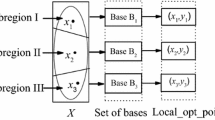Abstract
Bilevel programming has been proposed for dealing with decision processes involving two decision makers with a hierarchical structure. They are characterized by the existence of two optimization problems in which the constraint region of the upper level problem is implicitly determined by the lower level optimization problem. In this paper a genetic algorithm is proposed for the class of bilevel problems in which both level objective functions are linear fractional and the common constraint region is a bounded polyhedron. The algorithm associates chromosomes with extreme points of the polyhedron and searches for a feasible solution close to the optimal solution by proposing efficient crossover and mutation procedures. The computational study shows a good performance of the algorithm, both in terms of solution quality and computational time.
Similar content being viewed by others
References
Bard, J. F. (1998). Practical bilevel optimization. Algorithms and applications. Dordrecht: Kluwer Academic.
Bazaraa, M. S., Sherali, H. D., & Shetty, C. M. (1993). Nonlinear programming. Theory and algorithms (2nd ed.). New York: Wiley.
Calvete, H. I., & Galé, C. (1998). On the quasiconcave bilevel programming problem. Journal of Optimization Theory and Applications, 98(3), 613–622.
Calvete, H. I., & Galé, C. (2004). Solving linear fractional bilevel programs. Operations Research Letters, 32(2), 143–151.
Calvete, H. I., Galé, C., & Mateo, P. M. (2008). A new approach for solving linear bilevel problems using genetic algorithms. European Journal of Operational Research, 188(1), 14–28.
Charnes, A., & Cooper, W. W. (1962). Programming with linear fractionals. Naval Research Logistics Quaterly, 9, 181–186.
Dempe, S. (2002). Foundations of bilevel programming. Dordrecht: Kluwer Academic.
Dempe, S. (2003). Annotated bibliography on bilevel programming and mathematical programs with equilibrium constraints. Optimization, 52, 333–359.
Goldberg, D. E. (1989). Genetic algorithms in search, optimization and machine learning. Reading: Addison-Wesley.
Hansen, P., Jaumard, B., & Savard, G. (1992). New branch-and-bound rules for linear bilevel programming. SIAM Journal on Scientific and Statistical Computing, 13(5), 1194–1217.
Hejazi, S. R., Memariani, A., Jahanshahloo, G., & Sepehri, M. M. (2002). Linear bilevel programming solution by genetic algorithm. Computers and Operations Research, 29, 1913–1925.
Holland, J. H. (1975). Adaptation in natural and artificial systems. Ann Arbor: University of Michigan Press.
Mathieu, R., Pittard, L., & Anandalingam, G. (1994). Genetic algorithms based approach to bi-level linear programming. RAIRO-Operations Research, 28(1), 1–22.
Michalewick, Z. (1996). Genetic algorithms + data structures = evolution programs (3rd ed.). Berlin: Springer.
Nishizaki, I., Sakawa, M., Niwa, K., & Kitaguchi, Y. (2002). A computational method using genetic algorithms for obtaining Stackelberg solutions to two-level linear programming problems. Electronics and Communications in Japan, Part 3, 85(6), 55–62.
Reeves, C. R. (1997). Genetic algorithms for the operations researcher. INFORMS Journal on Computing, 9(3), 231–250.
Savard, G. (1989). Contribution à la programmation mathématique à deux niveaux. PhD thesis, Ecole Polytechnique de Montréal, Université de Montréal, Montréal, QC, Canada.
Author information
Authors and Affiliations
Corresponding author
Rights and permissions
About this article
Cite this article
Calvete, H.I., Galé, C. & Mateo, P.M. A genetic algorithm for solving linear fractional bilevel problems. Ann Oper Res 166, 39–56 (2009). https://doi.org/10.1007/s10479-008-0416-0
Published:
Issue Date:
DOI: https://doi.org/10.1007/s10479-008-0416-0




